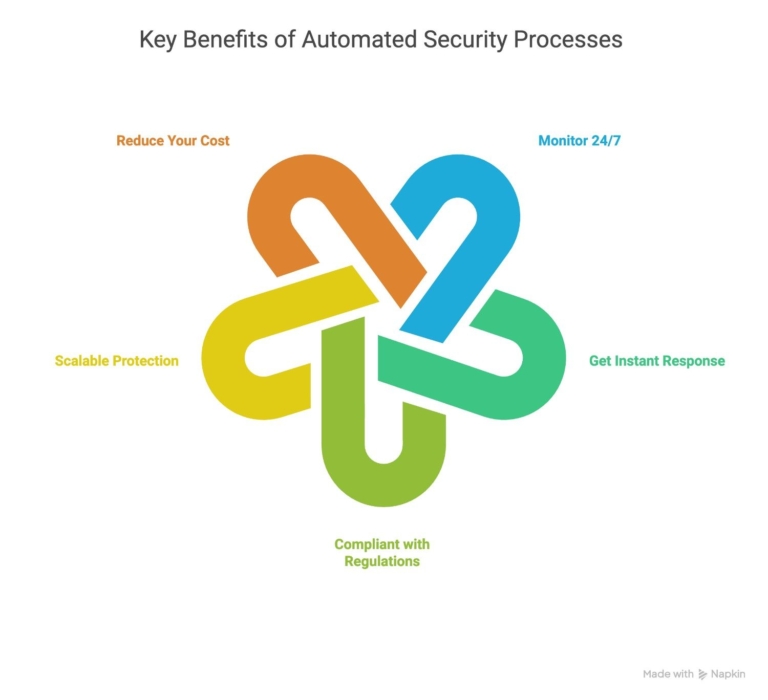Greetings! I'm Aneesh Sreedharan, CEO of 2Hats Logic Solutions. At 2Hats Logic Solutions, we are dedicated to providing technical expertise and resolving your concerns in the world of technology. Our blog page serves as a resource where we share insights and experiences, offering valuable perspectives on your queries.

Quick Summary
E-commerce stores lose millions to cyber threats while spending heavily on manual security monitoring that’s slow and error-prone. RPA (Robotic Process Automation) creates digital security guards that work around the clock, automatically detecting fraud, monitoring compliance, and protecting customer data without human intervention. RPA helps to upgrade security from a costly burden into a competitive advantage.
E-commerce stores face significantly higher cybersecurity risks than many other business types. According to recent studies, 84% of E-commerce merchants experienced fraud attacks within the past 12 months.
E-commerce stores are prime targets because they handle sensitive customer data, payment information, and valuable business intelligence. Every transaction creates potential entry points for cybercriminals. Thus making robust security measures for your online store is essential.
Find which security processes in your store can be automated for maximum impact?
Why Manual Security Processes Are No Longer Sufficient
Your security team can’t monitor every transaction, check every user login, or audit every data access point manually. The scale of modern E-commerce operations is beyond human capabilities.
Manual processes also introduce human error. When your team manually reviews security logs, monitors compliance requirements, or responds to threats, delays and mistakes become inevitable. A single oversight can expose your entire customer database to cybercriminals.
Why Use Robotic Process Automation for Data Security
Robotic Process Automation (RPA) helps maintain your security operations by handling repetitive, rule-based security tasks automatically.
RPA bots can monitor user behavior patterns, automatically flag suspicious activities, and ensure compliance with regulations like GDPR and PCI DSS. They respond to security incidents in real-time without human intervention.
What is Robotic Process Automation (RPA)?

RPA in e-commerce uses software robots to automate business processes that normally require human intervention. These bots integrate with your existing systems through APIs, databases, and user interfaces, following predefined rules and workflows. They help ensure consistent security processes across your organization.
How RPA and Data Security work together?
Data security in E-commerce involves protecting customer information, payment data, business intelligence, and operational systems. RPA helps improve data security by automating critical security processes. This makes them more consistent and comprehensive.
RPA bots automatically classify sensitive data and apply appropriate security controls based on predefined rules. They continuously assess user behavior patterns and system activities to maintain compliance with data protection regulations like GDPR and PCI DSS. This creates an additional security layer that works alongside your existing security tools.
Key Benefits of Automated Security Processes
Take a look at how automating the security process will benefit your business:

Monitor 24/7
RPA bots monitor security events and data access patterns 24/7, even when your team is offline.
Get Instant Response
Automated systems can respond to security incidents in seconds rather than hours, minimizing potential damage.
Compliant with Regulations
RPA ensures every security process complies with regulations like PCI DSS and GDPR.
Scalable Protection
As your business grows, RPA scales with you without requiring proportional increases in security staff.
Reduce Your Costs
Automation reduces security operations costs by 40-70% while improving protection quality.
Where to Use RPA for Data Security in E-commerce
Here are some critical e-commerce areas where you can implement RPA:
Customer Data Protection and Privacy Management
Your customers trust you with their personal information, payment details, and shopping preferences. This data represents both your greatest asset and your biggest liability.
Personal Information Handling: RPA bots automatically identify and classify personal data as it enters your systems. They apply appropriate encryption, access controls, and retention policies based on data sensitivity and regulatory requirements.
Payment Processing Security
Payment security failures can destroy customer trust and result in devastating financial penalties. PCI DSS compliance alone involves hundreds of security requirements that must be consistently maintained.
PCI DSS Compliance Monitoring: RPA continuously monitors your payment processing environment, checking security configurations, access controls, and data handling procedures. Bots generate compliance reports automatically and alert you to any violations before they become serious problems.
Inventory and Order Management Security
Your inventory and order data reveals business strategies, supplier relationships, and customer behavior patterns. Protecting this information prevents competitive intelligence theft and maintains operational security.
Supply Chain Data Protection: RPA monitors access to supplier information, pricing data, and inventory levels. Bots ensure only authorized personnel can view sensitive supply chain data and automatically log all access attempts.
Order Processing Integrity: RPA verifies order authenticity, checks for duplicate or fraudulent orders, and ensures order data remains accurate throughout fulfillment. This prevents both fraud and legitimate errors that could disrupt operations.
User Access Control and Authentication
Every employee, contractor, and system integration creates potential security vulnerabilities. Managing user access manually becomes impossible as your organization grows.
Account Management Automation: RPA automatically provisions user accounts, applies appropriate permissions based on roles, and deactivates accounts when employees leave. This ensures consistent access control and eliminates human errors in permission management.
Privilege Escalation Monitoring: RPA continuously monitors user activities, detecting when users attempt to access data or systems beyond their authorization. Unusual access patterns trigger immediate alerts and can automatically restrict access until human review occurs.
Tired of manual security processes?
Common Challenges and How to Overcome Them
During the implementation you may face certain challenges. Here’s how to fix them:
Integration Complexity Issues
Legacy systems often lack modern APIs, making RPA integration challenging. Address this by developing secure custom integration points and planning legacy system modernization to improve automation capabilities. Always test integrations thoroughly in non-production environments to identify and resolve issues before deployment.
Change Management and Team Adoption
Security teams may resist automation, fearing job displacement or loss of control. Address these concerns through education, training, and clear communication about how automation enhances rather than replaces human expertise. Involve security professionals in bot development and optimization to ensure automation meets operational needs and maintains team buy-in.
Security vs. Automation Balance
Automation can introduce new security risks if not implemented properly. Balance automation benefits against security requirements by implementing proper access controls, monitoring, and fail-safe mechanisms. Conduct regular security assessments of automation systems to ensure ongoing protection and identify potential vulnerabilities.
Scaling Challenges and Solutions
As automation scales, management complexity increases. Address scaling challenges through proper governance, standardized development practices, and comprehensive monitoring systems. Plan for growth by designing scalable architecture and establishing processes for managing large numbers of bots effectively.
Conclusion
RPA security automation turns your biggest headache into your best advantage. Start with one simple process like automating backup checks or monitoring suspicious logins and watch your security worries disappear while your business grows. Get the automation process easier with eCommerce automation experts who can fast-track your implementation and ensure maximum results.

Related Articles







